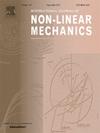Study on the camber angle of an aircraft radial tire: stress, contact, damage, and modal behaviors
IF 2.8
3区 工程技术
Q2 MECHANICS
International Journal of Non-Linear Mechanics
Pub Date : 2025-04-08
DOI:10.1016/j.ijnonlinmec.2025.105118
引用次数: 0
Abstract
During the landing process, there often exists a camber angle θ between the aircraft and the ground, complicating the tire-ground contact behavior and the consequential damage evolution. In this paper, a finite element analysis considering the cord-rubber composite structure of the aircraft radial tire, along with the hyperelasticity and Mullins effect of rubber is performed to investigate the effect of the camber angle θ on its stress distribution, the tire-ground contact behavior, the damage evolution, and the vibration characteristics. According to the stress analysis of the numerical results, under different θ, the tire shoulder is always the most vulnerable location where the stress concentrates the most and the Mullins damage indicator accumulates the most. The tire-ground contact behavior under different θ is analyzed and it is found that the vertical stiffness-displacement curves can be divided into three regimes due to the different involvement of the tire shoulder in the tire-ground contact process. The largest Mullins damage is first detected in the cross-section surface which is 30° from the middle of the contact region while as the load increases, the Mullins damage in the contact region increases rapidly and exceeds that in the 30° surface. Moreover, the vibration characteristics of the non-damaged tire and the damaged tire are extracted and compared. Different degrees of decrease in the natural frequencies are observed while no change is detected in modal shapes when Mullins damage is introduced. This paper reveals the importance of the tire shoulder in the tire structure design and the tire-ground contact process, and provides an insight into the damage monitoring technique of the aircraft radial tire.
飞机子午线轮胎的弯曲角研究:应力、接触、损伤和模态行为
在着陆过程中,飞机与地面之间往往存在一个外倾角θ,这使得轮胎与地面的接触行为以及随之而来的损伤演变变得更加复杂。本文考虑了飞机子午线轮胎的帘布橡胶复合结构以及橡胶的超弹性和 Mullins 效应,进行了有限元分析,研究了外倾角 θ 对其应力分布、轮胎与地面接触行为、损伤演变和振动特性的影响。根据数值结果的应力分析,在不同的θ条件下,胎肩始终是应力最集中、Mullins损伤指标累积最多的脆弱部位。分析了不同 θ 下的轮胎与地面接触行为,发现由于胎肩在轮胎与地面接触过程中的参与程度不同,垂直刚度-位移曲线可分为三种状态。最大的 Mullins 损伤首先出现在距接触区中部 30° 的横截面上,而随着载荷的增加,接触区的 Mullins 损伤迅速增加,并超过了 30° 表面的 Mullins 损伤。此外,还提取并比较了未损坏轮胎和损坏轮胎的振动特性。在引入 Mullins 损伤时,固有频率有不同程度的下降,而模态振型没有变化。本文揭示了胎肩在轮胎结构设计和轮胎与地面接触过程中的重要性,并为飞机子午线轮胎的损伤监测技术提供了启示。
本文章由计算机程序翻译,如有差异,请以英文原文为准。
求助全文
约1分钟内获得全文
求助全文
来源期刊
CiteScore
5.50
自引率
9.40%
发文量
192
审稿时长
67 days
期刊介绍:
The International Journal of Non-Linear Mechanics provides a specific medium for dissemination of high-quality research results in the various areas of theoretical, applied, and experimental mechanics of solids, fluids, structures, and systems where the phenomena are inherently non-linear.
The journal brings together original results in non-linear problems in elasticity, plasticity, dynamics, vibrations, wave-propagation, rheology, fluid-structure interaction systems, stability, biomechanics, micro- and nano-structures, materials, metamaterials, and in other diverse areas.
Papers may be analytical, computational or experimental in nature. Treatments of non-linear differential equations wherein solutions and properties of solutions are emphasized but physical aspects are not adequately relevant, will not be considered for possible publication. Both deterministic and stochastic approaches are fostered. Contributions pertaining to both established and emerging fields are encouraged.

 求助内容:
求助内容: 应助结果提醒方式:
应助结果提醒方式:


